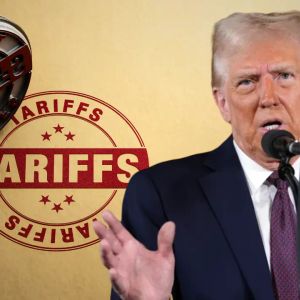President Donald Trump’s formula for calculating tariffs, detailed in a statement from the United States Trade Representative (USTR) on Wednesday night, bases tariff rates on trade imbalances rather than matching the tariff and trade barrier levels imposed by other countries. Did it all come from artificial intelligence (AI)? Some netizens think so. According to details shared on the US Trade Representative website, the formula calculates a country’s trade surplus with the US as a percentage of its total exports, then divides that figure by two to determine the tariff rate. For instance, China, which recorded a $295 billion trade surplus with the US in 2024 on total exports of $438 billion, had a trade imbalance ratio of 68%. Applying Trump’s formula, the resulting tariff rate was 34%. The same calculations applied to other “competitive” economies, including Japan, South Korea, and the European Union (EU). Not even countries where the US runs a trade surplus were not exempt from tariffs. These nations were subjected to a flat 10% rate, as were those where trade balances were relatively neutral. The USTR defended this approach, propounding that it was a practical way to achieve Trump’s long-standing goal of reducing trade deficits. The statement read: “While individually computing the trade deficit effects of tens of thousands of tariff, regulatory, tax, and other policies in each country is complex, if not impossible, their combined effects can be proxied by computing the tariff level consistent with driving bilateral trade deficits to zero.” Confusion over Trump’s tariff rates As r eported by Cryptopolitan on Wednesday, the Trump administration made the “Liberation Day” announcement during an event at the White House Rose Garden. The president flipped a placard displaying the proposed tariff rates, which showed two sets of numbers: “tariffs charged to the USA” and the “discounted reciprocal tariff,” with the new formula applied. Some of the rates displayed by Trump differed slightly from those listed in the annex of his executive order. South Korea, for example, was assigned a 25% tariff on Trump’s board but was listed at 26% in the official annex. Prior to the press briefing, the Trump administration had insinuated that the tariff rates would take into account both tariff and non-tariff barriers, including taxes and currency manipulation. The White House had coined the formula as an attempt to “level the playing field,” but critics assert that it puts America’s foreign trade at risk. Did Donald Trump use AI to create a Tariff formula? Shortly after the announcement, netizens typed in their theories of where Trump’s camp came up with the methodology while trying to experiment with different AI chatbots. Crypto market influencer IamDCinvestor quoted a post from an X user, who shared a snapshot of a ChatGPT thread that broke down the tariff formula. “FFS, it’s true. I was able to duplicate it in ChatGPT. It also told me that this idea hadn’t been formalized anywhere before and that it was something it came up with. FFS, the Trump administration is using ChatGPT to determine trade policy,” he posted. Trump team just asked ChatGPT and shipped it 😭😭 pic.twitter.com/tBypZ7GMWf — Cobie (@cobie) April 3, 2025 Other users confirmed they saw similar responses when testing the calculation method with AI models like Grok, Claude, and Deepseek. “ Now the huge investment in AI is making a lot of sense ,” a commenter joked. US trade policy is based on trade relationships The February 13 memorandum leading up to the tariff announcement mandated an analysis of trade relationships, including tariffs, taxes, non-tariff barriers, currency manipulation, and other structural impediments to fair competition. The order did not explicitly mention trade balances as a determining factor, but it did talk about concerns about non-reciprocal trade practices contributing to persistent US trade deficits. Trump’s formula also included two economic parameters, the price elasticity of import demand and the elasticity of import prices with respect to tariffs, but they were set at values that canceled each other out. As a result, their influence on the final tariff rates was arguably negligible. “Trump’s tariff formula is further evidence he is laser-focused on reversing these imbalances. The problem for treasuries is that without $ exports, foreigners can’t buy bonds. The Fed and banking system must step up to ensure a well-functioning treasury market, which means Brrrr,” posted BitMEX co-founder Arthur Hayes on X, referring to the need for the US Treasury to print more money if dollar exports nosedive. A commenter on Hayes’ post inquired if tariffs alone could address the trade deficit issue, cautioning that monetary policy adjustments might exacerbate inflation. “Tariffs don’t address the root cause of the deficit, and playing around with QE can only fuel inflation. Wonder what Powell thinks of all this. The only beneficiary from all this could be BTC, but let’s see how the dynamics with institutions/corporates being in the equation would play,” they wrote . Cryptopolitan Academy: Tired of market swings? Learn how DeFi can help you build steady passive income. Register Now















